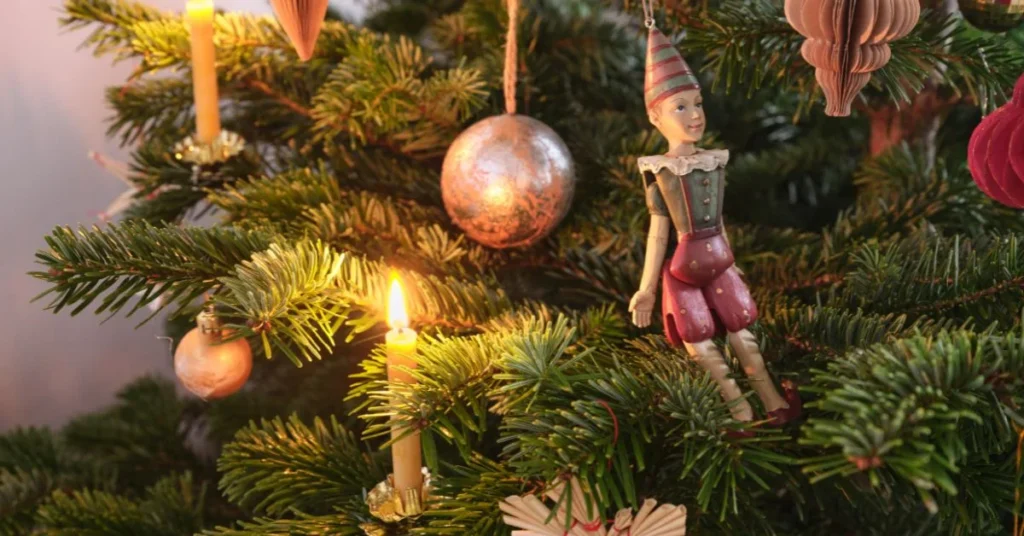For many, the holiday season is a time of nostalgia—rituals passed down through generations, melodies that signal the arrival of winter, and ornaments that do more than decorate. Among these symbols, 12 Days of Christmas ornaments carry a unique legacy, tying the festive charm of holiday décor with the enduring lyrics of one of the most iconic carols in history. These ornaments are not just baubles; they are storytellers, heirlooms, and increasingly, a creative expression of personal or cultural identity.
The term 12 Days of Christmas ornaments refers to themed holiday decorations inspired by the beloved carol, “The Twelve Days of Christmas.” Each day in the song corresponds to a specific gift—from a partridge in a pear tree to twelve drummers drumming—and these motifs have been turned into collectible ornaments, often displayed sequentially or as part of a set.
Beyond being festive, these ornaments carry layers of meaning—both religious and secular—and have become popular in both traditional holiday households and modern artistic interpretations. This article unpacks their history, symbolism, styles, and how to incorporate them into your own seasonal traditions.
The Historical Origins of “The Twelve Days of Christmas”
Before we delve into the ornaments themselves, it’s essential to understand the song that inspires them. “The Twelve Days of Christmas” dates back to at least the 18th century in England, though some argue it may have even older French roots. It is structured as a cumulative verse—each verse builds upon the last, with increasingly grand gifts.
The Days and Their Symbols:
- A Partridge in a Pear Tree
- Two Turtle Doves
- Three French Hens
- Four Calling Birds
- Five Golden Rings
- Six Geese a-Laying
- Seven Swans a-Swimming
- Eight Maids a-Milking
- Nine Ladies Dancing
- Ten Lords a-Leaping
- Eleven Pipers Piping
- Twelve Drummers Drumming
Each symbol has been interpreted variously over time—from representing Christian virtues to symbolic reflections of 18th-century British life.
The Tradition of Ornaments and Their Cultural Significance
Ornaments have long played a central role in Christmas décor. From glass baubles in Victorian England to hand-carved wooden figures in Germany, ornaments serve as visual markers of memory and identity.
Why 12 Days Ornaments Matter:
- Narrative structure: Each ornament tells part of a larger story.
- Collectibility: Sets are often passed down or gifted year by year.
- Symbolism: The carol’s contents lend themselves to deeper meanings—both sacred and secular.
- Artistry: Artists reinterpret the gifts in modern and classic designs.
Displaying all 12 together is like arranging a visual Advent calendar—where each ornament unfolds a deeper layer of seasonal storytelling.

Materials and Styles: How the 12 Days Come to Life
The market for 12 Days of Christmas ornaments is as diverse as the carol is iconic. You’ll find everything from rustic farmhouse-style designs to sleek, modern interpretations.
Common Materials:
- Blown Glass: Often imported from Europe; rich in color and detail.
- Porcelain: Traditional and delicate, often hand-painted.
- Wood: Folk-art inspired and eco-conscious.
- Metal or Wire: Sleek, modern designs; sometimes interactive or movable.
- Fabric/Felt: Often handmade, soft to the touch, and safe for children.
Design Styles:
- Traditional: Realistic birds, Victorian outfits, classic holiday motifs.
- Whimsical: Cartoonish interpretations with playful colors.
- Modern Minimalist: Abstract representations with numbers and geometric shapes.
- Religious: Tied to Christian interpretations, featuring halos, robes, and scripture.
Collectors often choose a style that aligns with their home décor or emotional connection to the song.
Symbolic Interpretations of Each Ornament
There are multiple interpretations of the carol’s gifts. In one school of thought, particularly popular among religious educators, the song is an encoded catechism. While historians debate this, it’s worth noting some symbolic readings:
- Partridge in a Pear Tree: Jesus Christ (symbol of self-sacrifice)
- Two Turtle Doves: Old and New Testaments
- Three French Hens: Faith, Hope, and Charity
- Four Calling Birds: The Four Gospels
- Five Golden Rings: The first five books of the Bible (Pentateuch)
- Six Geese a-Laying: Days of creation
- Seven Swans a-Swimming: Seven sacraments or gifts of the Holy Spirit
- Eight Maids a-Milking: The Beatitudes
- Nine Ladies Dancing: Fruits of the Holy Spirit
- Ten Lords a-Leaping: The Ten Commandments
- Eleven Pipers Piping: Eleven faithful Apostles
- Twelve Drummers Drumming: Apostles’ Creed’s twelve points of doctrine
Others interpret the list as a celebration of abundance, joy, and rhythm—a seasonal fantasy of gifts that grows more absurd and delightful with each verse.
Displaying the Ornaments: Ideas and Inspirations
Whether you own a set or are building one piece by piece, how you display your 12 Days ornaments matters. Here are several creative approaches:
1. Sequential Tree Decoration
Place each ornament on the tree in order, either day-by-day starting December 25 or all at once for visual storytelling.
2. Wall-Hung Calendar
Mount small shelves or pegs along a decorative wall banner and add one ornament each day.
3. Mantel Showcase
Use a tiered display or small artificial trees on the mantel, arranging the ornaments by number.
4. Centerpiece Display
Create a tabletop scene where each “day” is represented by a small vignette—ideal for holiday dinners.
5. Window Garland
Suspend the ornaments from a garland along a window or staircase, allowing sunlight to highlight glass or metallic designs.
Combining visual storytelling with holiday décor turns these ornaments into a focal point of your festive environment.
The Role of Craft and Personalization
In an age of mass production, many families return to the practice of making their own 12 Days of Christmas ornaments—either as a shared activity or a personal creative challenge.
DIY Approaches:
- Felt & Embroidery: Personalize with initials or stitching.
- Clay Sculpting: Create small figurines representing each gift.
- Paper Craft: Great for kids; uses folding and layering.
- Painting on Wood Discs: Rustic and reusable.
- Digital Illustration: Print designs and transfer onto ceramic or acrylic blanks.
The act of making these ornaments can itself become a family tradition, adding meaning and bonding to the holiday season.
Popular Brands and Collectible Series
Though we don’t rely on external references, it’s notable that in the real world, many companies create collectible 12 Days of Christmas ornament sets. Some are released yearly, building anticipation and offering long-term collectors something to look forward to.
Features of collectible sets:
- Numbered editions
- Storybook inserts
- Storage boxes with velvet lining
- Certification of authenticity
These products transform the 12 Days concept from a carol into a long-term hobby or investment—both sentimental and artistic.
Educational Value for Children
Ornaments are more than decoration—they’re teaching tools, especially for children.
Lessons to Share:
- Numerical Order: Helps kids learn counting through song and visuals.
- Cultural History: Opens doors to explore traditions, symbolism, and storytelling.
- Craftsmanship: Teaches value in handmade items over disposable decor.
- Religious Meaning: For those who celebrate Christmas religiously, the ornaments provide an entry to biblical lessons.
Involving children in displaying or making 12 Days ornaments embeds them in tradition through active learning.
Sustainability and Ethical Design
As awareness grows around sustainable holiday practices, more families are choosing eco-conscious ornament sets that reflect their values.
Key traits of sustainable 12 Days ornaments:
- Made from recycled or natural materials
- Produced by local artisans
- Packaged without plastic
- Designed to last for generations
Heirloom ornaments tell not only the story of Christmas, but also of values preserved across generations.
From Tradition to Trend: Why the 12 Days Still Matter
In a fast-paced world of ever-changing trends, the 12 Days of Christmas ornaments endure because they tap into narrative, nostalgia, and meaning. As part of an evolving Christmas tradition, they serve a unique function:
- They anchor the holiday in storytelling.
- They bring rhythm and ritual to the post-Christmas days.
- They create a tactile timeline of the season—where each ornament marks a moment.
This makes them more than decoration. They’re legacy in visual form.
Conclusion
The 12 Days of Christmas ornaments represent more than a line from a carol or a festive décor trend—they are a celebration of narrative, tradition, and the human instinct to mark time with ritual. Whether handcrafted or curated, whimsical or sacred, minimalist or richly detailed, these ornaments invite us to pause and consider not just the gifts we give but the meanings we attach to them.
From counting down the days of celebration to passing on traditions across generations, the 12 Days of Christmas ornaments transform a simple song into a living memory—year after year, tree after tree.
Frequently Asked Questions (FAQs)
1. What are 12 Days of Christmas ornaments?
These are themed ornaments inspired by the “Twelve Days of Christmas” carol, with each ornament representing one day’s gift.
2. When should I start displaying the 12 Days of Christmas ornaments?
Traditionally, the 12 Days begin on December 25 and end on January 5, though some display them earlier during Advent.
3. Are 12 Days ornaments religious in nature?
They can be, depending on interpretation. Some people see symbolic Christian meanings, while others view them as cultural and festive.
4. Can I make my own 12 Days of Christmas ornaments?
Yes. DIY sets are popular and meaningful. You can use materials like felt, wood, or clay to personalize each ornament.
5. Are 12 Days of Christmas ornaments collectible?
Absolutely. Many companies release annual collectible sets that become family heirlooms or artistic investment pieces.
For more information, click here.









